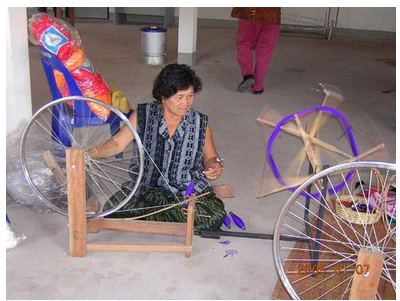
Textile Industries
Manufacturing Industries of Class 10
Textile industry
The textile industry occupies unique position in the Indian economy, because it contributes significantly to industrial production (14 per cent), employment generation (35 million persons directly – the second largest after agriculture) and foreign exchange earnings (about 24.6 per cent). It contributes 4 per cent towards GDP. It is the only industry in the country, which is self-reliant and complete in the value chain i.e., from raw material to the highest value added products.

Value addition in the textile industry
HISTORY OF COTTON TEXTILES IN INDIA:
In ancient India, cotton textiles were produced with hand spinning and handloom weaving techniques. After the 0ptth century, power-looms came into use. Our traditional industries suffered a setback during the colonial period because they could not compete with the mill-made cloth from England. Today, there are nearly 1600 cotton and human made fibre textile mills in the country. About 80 per cent of these are in the private sector and the rest in the public and cooperative sectors. Apart from these, there are several thousand small factories with four to ten looms. In the early years, the cotton textile industry was concentrated in the cotton growing belt of Maharashtra and Gujarat. cotton textile industry Yarns, Labels Industry India Cotton textile industryYarns, Labels Industry India
REASONS FOR CONCENTRATION IN GUJARAT AND MAHARASTRA:
The cotton textile is a highly localised industry right from the beginning mainly in the cotton growing belt of Maharashtra and Gujarat. Localisation factors were :
- Availability of raw cotton in Gujrat and Maharashtra.
- Traditional labour is available in these states.
- Moist climate in these states also helps in spinning.
- Infrastructure facilities are developed in these states.
- Port facilities are located near these states.
FEATURES OF COTTON TEXTILE INDUSTRY:
- It is an agro-based industry thus a large numbers of farmers get their living from it.
- There are a line of activities from cotton Ball pluckers to workers engaged in weaving, spinning, dyeing, designing, packaging, tailoring and sewing.
- Many other ancillary industries have come up around cotton mills such as chemicals and dyes engineering works, packaging materials and mill store hence it is a labour intensive industry.
- Cotton textile industry is an example of centralized and decentralized industry.
- Features like spinning is cetralised in Maharashtra, Gujarat and Tamil Nadu but weaving is highly decentralized for incorporating Traditional skill and designs of weaving in silk, cotton Zari, embroidery etc.
- India has world class production in spinning, but weaving supplies low quality of fabric as it cannot use much of the high quality yarn produced in the country.
- Weaving is done by handloom, power loom and in mills.
- The handspun khadi provides large scale employment to weavers in their homes as cottage industry.
- India has bright future in cotton textile industry and wide scope in exports.
- Exporting countries include Japan, U.S.A., Russia, France, Singapore, East European countries, African countries, Nepal and Srilanka.
- At around 34 million, India stands second largest installed capacity of spindles in the world after China.
- One fourth of the total trade of cotton yarn comes from India in the world trade.
- However, our trade in garments is only 4 per cent of the world’s total. Our spinning mills are competitive at the global level and capable of using all the fibres we produce.
THE PROBLEMS OF WEAVING SECTOR:
- The weaving, knitting and processing units cannot use much of the high quality yarn that is produced in the country.
- There are some large and modern factories in these segments, but most of the production is fragmented in small units, which cater to the local market.
- This mismatch between the large and small unit is a major drawback for the industry.
- As a result, many of our spinners export cotton yarn while apparel garment manufactures have to import fabric.

Cotton weaving
PROBLEMS OF COTTON TEXTILE INDUSTRY:
- (Most of the production is in fragmented small units, which cater to the local market.
- The weaving knitting and processing units cannot use much of the high quality yarn that is produced in the country.
- Scarcity of good quality cotton, outdated machinery, erratic power supply, low productivity of labour and stiff competition with synthetic fiber industry are some other major problems faced by the industry.
Trade: India exports yarn to Japan. Our trade in garments is only 4% of the world's total. Readymade garments are exported to U.S.A., U.K, Russia, France, European countries, Nepal, Singapore, Sri-Lanka and African countries.







